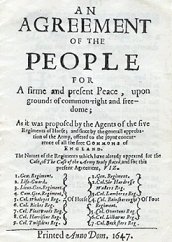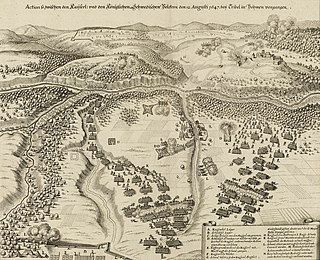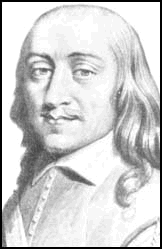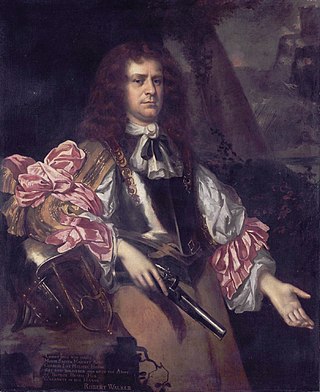Related Research Articles

The Levellers were a political movement active during the Wars of the Three Kingdoms who were committed to popular sovereignty, extended suffrage, equality before the law and religious tolerance. The hallmark of Leveller thought was its populism, as shown by its emphasis on equal natural rights, and their practice of reaching the public through pamphlets, petitions and vocal appeals to the crowd.

.

1647 (MDCXLVII) was a common year starting on Tuesday of the Gregorian calendar and a common year starting on Friday of the Julian calendar, the 1647th year of the Common Era (CE) and Anno Domini (AD) designations, the 647th year of the 2nd millennium, the 47th year of the 17th century, and the 8th year of the 1640s decade. As of the start of 1647, the Gregorian calendar was 10 days ahead of the Julian calendar, which remained in localized use until 1923.

The New Model Army or New Modelled Army was a standing army formed in 1645 by the Parliamentarians during the First English Civil War, then disbanded after the Stuart Restoration in 1660. It differed from other armies employed in the 1639 to 1653 Wars of the Three Kingdoms in that members were liable for service anywhere in the country, rather than being limited to a single area or garrison. To establish a professional officer corps, the army's leaders were prohibited from having seats in either the House of Lords or House of Commons. This was to encourage their separation from the political or religious factions among the Parliamentarians.
This is a timeline of events leading up to, culminating in, and resulting from the English Civil Wars.

The Second English Civil War took place between February and August 1648 in England and Wales. It forms part of the series of conflicts known collectively as the 1639–1653 Wars of the Three Kingdoms, which include the 1641–1653 Irish Confederate Wars, the 1639–1640 Bishops' Wars, and the 1649–1653 Cromwellian conquest of Ireland.

The Putney Debates, which took place from 28 October to 8 November 1647, were a series of discussions over the political settlement that should follow Parliament's victory over Charles I in the First English Civil War. The main participants were senior officers of the New Model Army who favoured retaining Charles within the framework of a constitutional monarchy, and radicals such as the Levellers who sought more sweeping changes, including one man, one vote and freedom of conscience, particularly in religion.

The Banbury mutiny was a mutiny by soldiers in the English New Model Army. The mutineers did not achieve all of their aims and some of the leaders were executed shortly afterwards on 17 May 1649.
The Corkbush Field Mutiny occurred on 15 November 1647, during the early stages of the Second English Civil War at the Corkbush Field rendezvous, when soldiers were ordered to sign a declaration of loyalty to Thomas Fairfax, the commander-in-chief of the New Model Army (NMA), and the Army Council. When some refused to do this they were arrested, and one of the ringleaders, Private Richard Arnold, was executed.

Robert Lilburne (1613–1665) was an English Parliamentarian soldier, the older brother of John Lilburne, the well known Leveller. Unlike his brother, who severed his relationship with Oliver Cromwell, Robert Lilburne remained in the army. He is also classed as a regicide for having been a signatory to the death warrant of King Charles I in 1649. He was forty-seventh of the fifty nine Commissioners.
Colonel Sir Richard Ingoldsby was an English officer in the New Model Army during the English Civil War and a politician who sat in the House of Commons variously between 1647 and 1685. As a Commissioner (Judge) at the trial of King Charles I, he signed the king's death warrant but was one of the few regicides to be pardoned.
The Army Council was a body established in 1647 to represent the views of all levels of the New Model Army. It originally consisted of senior commanders, like Sir Thomas Fairfax, and representatives elected by their regiments, known as Agitators.
The Committee of Both Kingdoms,, was a committee set up during the Wars of the Three Kingdoms by the Parliamentarian faction in association with representatives from the Scottish Covenanters, after they made an alliance in late 1643.

Thomas Rainsborough, or Rainborowe, 6 July 1610 to 29 October 1648, was an English religious and political radical who served in the Parliamentarian navy and New Model Army during the Wars of the Three Kingdoms. One of the few contemporaries whose personal charisma and popularity rivalled that of Oliver Cromwell, he has also been described as "a soldier of impressive professional competence and peerless courage".
Robert Hammond was an officer in the New Model Army under Oliver Cromwell during the First English Civil War and a politician who sat in the House of Commons in 1654. He is best known for his year-long role in keeping Charles I of England in custody.
Events from the year 1646 in England. This is the fifth and last year of the First English Civil War, fought between Roundheads (Parliamentarians) and Cavaliers.
Events from the year 1648 in England. The Second English Civil War begins.
Events from the year 1650 in England, second year of the Third English Civil War.

Lieutenant-Colonel George Joyce was an officer and Agitator in the Parliamentary New Model Army during the English Civil War.
William Eyre, was an English Parliamentary army officer in the English Civil War and a Leveller.
References
- 1 2 3 Palmer, Alan; Palmer, Veronica (1992). The Chronology of British History. London: Century Ltd. pp. 182–183. ISBN 0-7126-5616-2.
- ↑ February 1647: An Ordinance, concerning the growth and spreading of Errors, Heresies, and Blasphemies, and for setting apart a day of Publike Humiliation, to seeke Gods assistance for the suppressing and preventing the same.
- 1 2 3 4 5 6 7 8 9 Williams, Hywel (2005). Cassell's Chronology of World History . London: Weidenfeld & Nicolson. pp. 261–262. ISBN 0-304-35730-8.
- ↑ "Christmas abolished! - Why did Cromwell abolish Christmas?". Oliver Cromwell. The Cromwell Association. 2001–2005. Retrieved 2011-10-23.
- ↑ Godwin, William (1826). History of the Commonwealth of England: To the death of Charles I. London: H. Colburn. Retrieved 2017-07-05.
- 1 2 3 "1647, British Civil Wars". Archived from the original on 30 September 2007. Retrieved 2007-09-16.
- ↑ Durston, Chris (December 1985). "Lords of misrule: The Puritan war on Christmas 1642–60". History Today . 35 (12): 7–14. Retrieved 2011-12-23.
- ↑ "The Engagement, 1648, British Civil Wars". Archived from the original on 27 September 2007. Retrieved 2007-09-16.